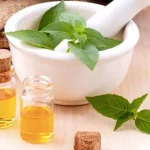Tulsi has many different names, such as Ocimum tenuiflorum and Holy Basil.
Tulsi & Tulasi both derived from Sanskrit. People recognise the Indian basil plant that is known for its sacredness, nutritional value, and medicinal importance. According to some research, different parts of plants treat different conditions, from improving digestion and mental health to boosting immunity.
In this article, we will explore the origins, benefits, types, reasons for its cultivation, medicinal uses, and much more about Indian Basil plant.
What is Tulsi?
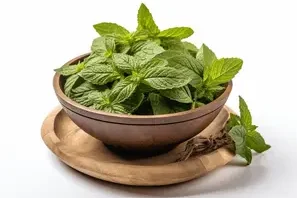
Indian basil is a plant with a life span of two years or more and an aromatic compound that produces essential oils. Furthermore, once planted, Holy Basil returns every year and grows to the same size.
Why do People Cultivate Tulsi ?

Farmers cultivate Indian basil plants for religious, traditional, and medicinal purposes.
They produce essential oils that aromatherapy practitioners use to help improve mood, reduce stress, and tend to increase attentiveness. Additionally, Practitioners commonly use Indian Basil in Ayurveda, particularly as Herbal Tea (Tulsi tea) and in remedies for cold and cough.
Physical Form and External Structure of Tulsi
Plant Structure

- It usually stands up straight and has multiple branches.
- It grows to a height of around 12-24 inches.
- Strong aromatic leaves having the colour green or purple.
Leaf Features
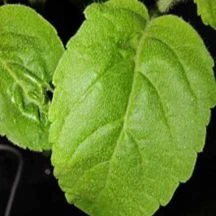
| Color and appearance | Hairy stems with green and purple leaves |
| Type | It has stalk that joins a leaf and stem |
| Shape | It has a leaf blade shaped like an egg which is 5 cm long. |
| Edges | Leaves edges have a slightly toothed appearance. |
| Arrangement | Tulsi leaves grow in a unique pattern, with pairs arranged opposite each other at right angles (decussate). |
| Scent | It has a strong and pleasant aroma. |
Flower Features
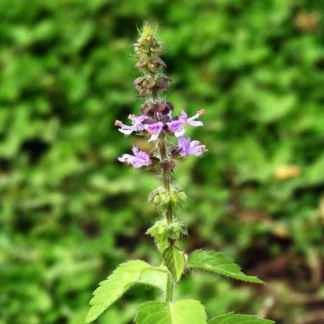
| Flower | Tulsi has small and purplish flowers. |
| Arrangement | Grouped closely together along long, thin stems that rise gracefully above the leaves |
Overall, the Indian Basil plant has a simple structure that makes it look attractive and has special components that make aromatic
Main Types of Tulsi Cultivated
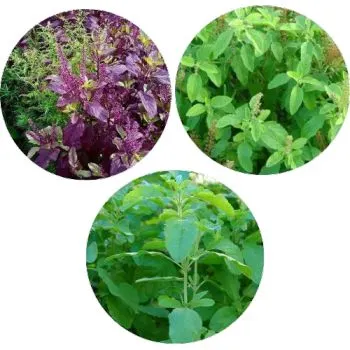
- Ram Tulsi
These types of tulsi are commonly cultivated and have bright green leaves.
- Krishna Tulsi
These Indian basil are less common and have darker purple leaves.
- Vana Tulsi
People often distinguished these as wild plants that they often find in forests and that are very common.
Phytonutrients in Tulsi

The simple definition of Phytonutrients is that plants produce and contain chemical compounds that have health benefits useful for humans.
Natural Compounds in Plant and Oil
Indian basil contains many nutrients or you can say Phytonutrients. Nutrients that provide like aroma, flavor, and health benefits pack the Holy Basil plant and oil.
These include the following key phytonutrients:
| Tannins | Antioxidant properties |
| Flavonoids | Anti-inflammatory |
| Eugenol | Antiseptic |
| Linalool and Camphor | Aromatic compound |
According to the study, It contains in a special group,10 neolignan compounds called Tulsinol A-J.
Aroma Compounds
Researchers have discovered more than 60 different aroma compounds in Indian basil by using advanced analysis. Its essential oil has an easily distinguishable fragrance, because of its mixture of compounds and minerals.
Commonly Found Compounds
| Camphor | Tulsi has 32 % of camphor as a compound which makes them smell fresh. |
| Eucalyptol | It has 19 % of eucalyptol as a compound which makes them have a cool and minty aroma. |
| ⍺-Bisabolene | Indian Basil plant has 17% of bisabolene as its compound which makes them smell pleasant and mild . |
| Eugenol | It has 14% of eugenol as compound which gives their oil a smell of spicy and clove like scent. |
| Germacrene and β-Bisabolene | Both have 11 % of its compound in tulsi which enhances its aroma. |
Tulsi : Origin and Historical Background
Mentioned in Ancient Texts
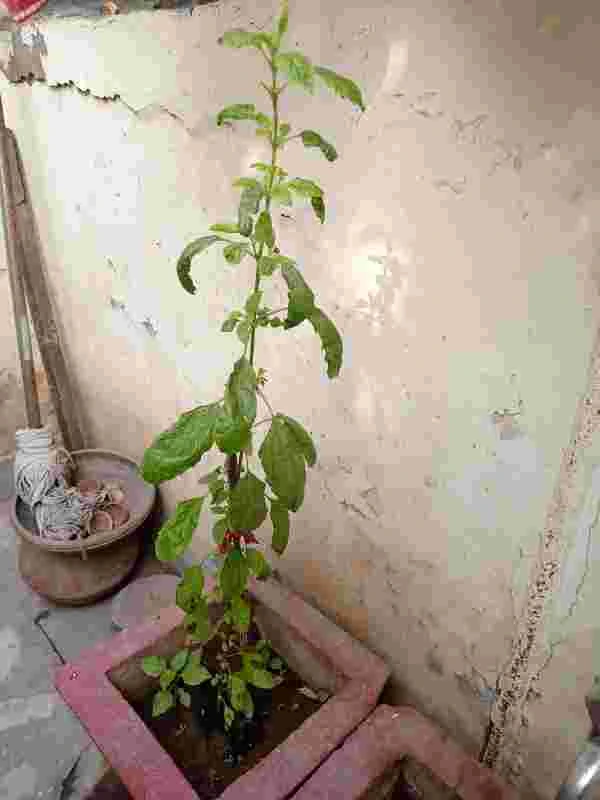
Indian culture has highly regarded Tulsi, also known as Ocimum tenuiflorum or Holy Basil or Vrinda, for around 5000 years. Different ancient texts like Vedas, Charaka Samhita and Sushruta Samhita mention Tulasi. In these texts,they explained how it has immense medicinal and spiritual power and value.
Tulsi in Hindu Mythology
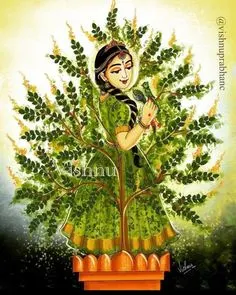
People symbolize Tulsi as a woman and consider her an earthly manifestation of the Goddess Tulasi, an incarnation of Goddess Lakshmi. She is a devoted follower of Lord Vishnu/Krishna.
Many priests recommend offering its leaves in ritualistic worship of Lord Vishnu and his avatars like Krishna and Vitoba. Hindus use its leaves rituals such as Puja, and they beleives Tulsi Jal purifies the mind and body. They consider it an important part of Hindu festivals like Diwali, where they use its leaves as offerings to the deities.
- Backstory of Tulsi: Lord Vishnu has three wives, Goddess Lakshmi is his favorite because of this the two wives get jealous and curse Laksmi to be born as a plant on the Earth.
Tulsi Vrindavan
In Hindu houses,People plant it in the centre of the courtyard because of the following reasons :
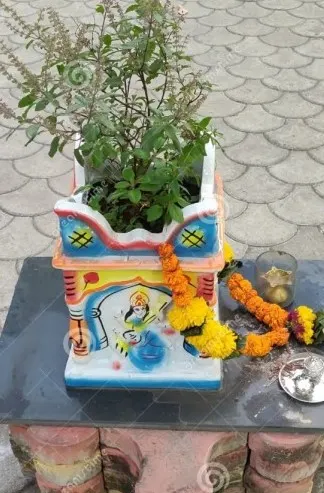
Religious Importance
People consider Tulsi a sacred plant and is related to Lord Vishnu and Goddess Lakshmi in Hindu culture. Furthermore, planting it in the central part of your courtyard, not only allows people to worship but also you to do puja daily.

Environment Purification
It has the ability to purify the air by a good amount of oxygen and tends to absorb the harmful carbon dioxide which automatically leads to the improvement of a household’s air quality.

Medicinal and Health Benefits
Tulsi medicinal uses helps to prevent diseases by keeping it in courtyard or near the house and makes it easily available for home remedies.
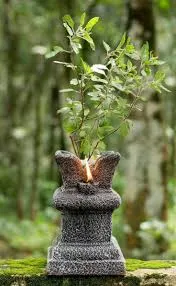
Warding Off Negative Energy
It is believed that the Indian basil plant can ward off negative energies and let positive energy and vibration enter into homes.
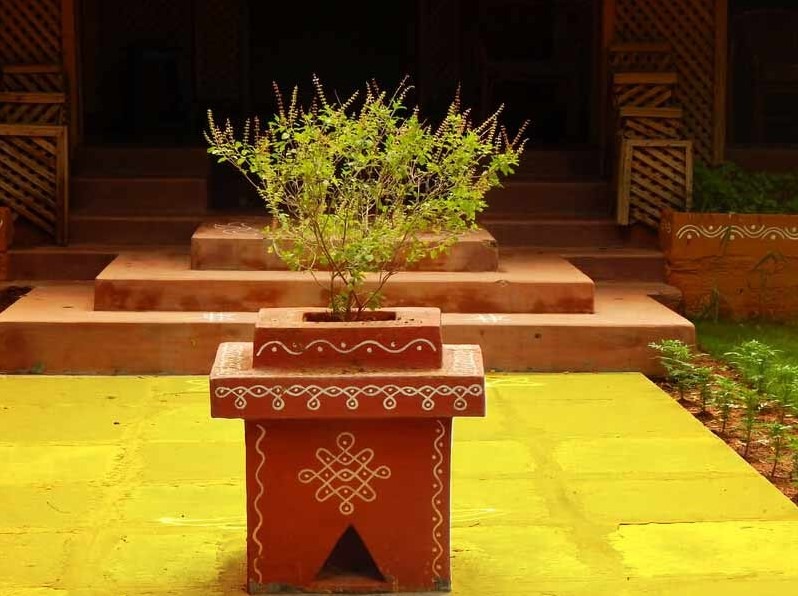
Architectural Role
Usually in Traditional Indian homes the courtyard or we can say Aangan is treated as the heart of the house and planting the Tulsi there can lead to spiritual practices in daily life.
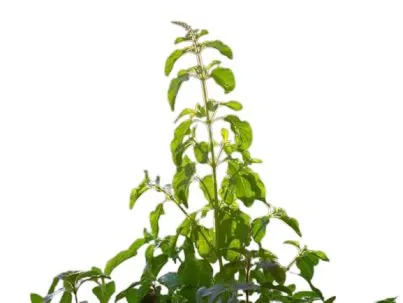
Refreshing Climate
This plant cools and refreshes the climate of the house, warm regions.

Protects from Misfortune
Its presence in the home is meant to bring prosperity and protect the family from misfortune .
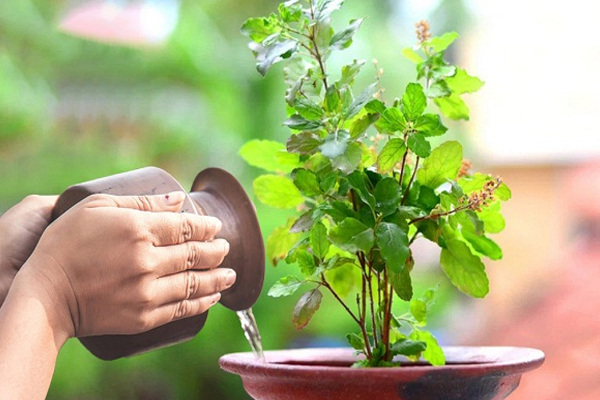
Connection to Nature
It helps family members to reconnect with nature by watering, worshipping, and also creating a habit of taking care of the plants or doing some activities of Tulsi plant care as a part of their daily routine.
Tulsi in Ayurveda
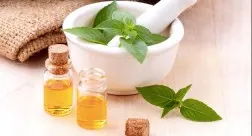
People regard as a natural substance that is helps the body adapt and cope with stress and improve overall health or you can say Adaptogen. Tulsi in Ayurveda is regarded as the holy plant that possesses therapeutic properties and is also used in systems of medicine. People know Indian Basil as the Elixir of Life because it has anti-inflammatory, antimicrobial, and adaptogenic properties that make your body healthy and can promote longevity and overall health.
Tulsi Benefits
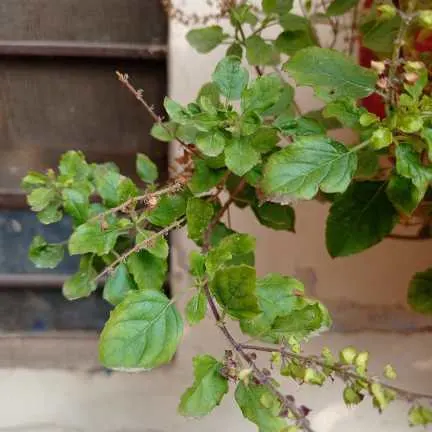
- Reduces Stress
One of the benefits of tulsi it contains adaptogenic properties that can help to reduce stress and anxiety
- Power of Antioxidant
Its drops and leaves are filled with rich antioxidants which helps to prevent cell damage.
- Act as Detoxifier
It’s a natural detoxifier that cleanses the liver and kidneys of the human body.
- Management of Weight
It is said that drinking its water helps to improve metabolism and maintain a healthy weight.
Uses of Tulsi
Worshipped in Hindu Culture

- Many priests recommend people to offer leaves of the plant in ritualistic worship of Lord Vishnu and also his avatars like Krishna and Vitoba.
- People use its leaves in rituals like Puja and are offer to Lord Vishnu.
- Tulsi Jal: Many believe that putting its leaves in water purifies one’s mind and body.
- Celebrant also organise Tulsi Vivah ,where they arrange a ceremonial marriage of the plant and the Lord Vishnu. It also signifies the end of monsoon season and the start of Hindu wedding season.
Used in Thai Cuisine

In Thailand, people also call holy basil ‘Kaphrao’; moreover, chiefs use Basil (Western version of Indian Basil )as a key ingredient in Thai dishes. They put them in stir-fry dishes made with Holy basil, parkour seafood, and rice.
Tulsi vs. Basil: Key Differences
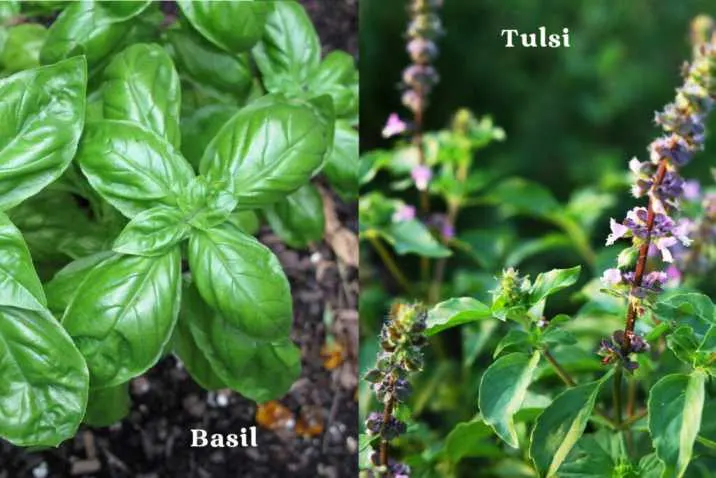
If we talk about the difference of Tulsi v/s Basil then we should know that they both have same starting name which is Ocimum and both herbs belong to the same family i.e. Lamiaceae which comprises mint plants and culinary herbs like rosemary,oregano, lavender catnip etc.
| Feature | Tulsi | Basil |
| Region | Indian Sub- continent | West (thailand) |
| Used In | Herbal tea and Ayurvedic Remedies. | Western cuisines recipes |
| Properties | Adaptogen, Detoxifier, Antioxidant. | Culinary Herb |
Tulsi products with Practical Application
There are so many Tulsi products that are used in making tea,skin and hair care and many more.
Herbal Tea

According to Ayurveda, Indian basil tea is an herbal infusion without any caffeine, full of nutrients and antioxidants.
Tulsi Powder

Tulsi leaves are dried up and ground into powder. Then this powder is:
- Used as Face masks ,
- Mixed in smoothies,
- Put in boiling water to help to ease the pain of sore throat.
Tulsi Oils
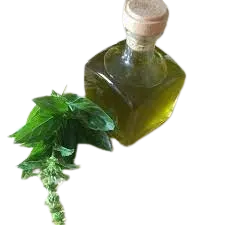
Indian basil oil is extracted from the leaves and then:-
- Used for its antimicrobial and anti-inflammatory properties.
- It is applied to skin infections or other skin issues.
- It is used for Aromatherapy and massages.
- Applied to relieve the joint pains.
- It can also be applied when one is suffering from Headache.
Ayurvedic Tulsi Drops
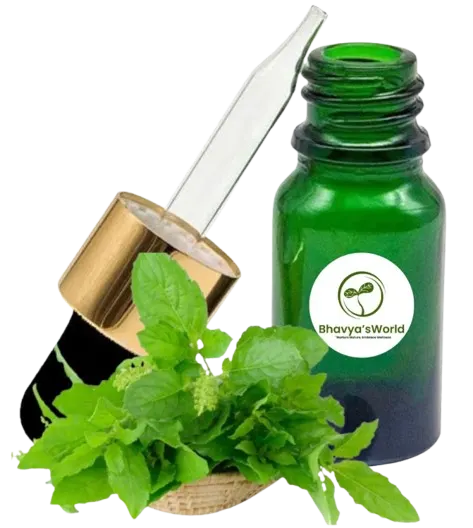
Its drops are put in the eyes for good eyesight.
Side Effects
Everything in excessive amounts can be harmful to the body and can have side effects. Even though it has so many benefits and can help with practically every issue a human body may have, there are certain things we should consider before using it.
- Over-consumption Risk: Too much taking of Indian basil in any form (food or medicine) can lead to overdose of Eugenol which eventually causes respiratory issues like fast breathing and vomiting blood while coughing.
- It is said that holy basil contains Eugenol, which helps to reduce respiratory issues. However, taking an excess of this can result in poisoning.
- Male Fertility Concerns: It can have a negative effect on male fertility.
- Blood Thinning: It leads to blood clotting, so individuals on blood thinners should consume it cautiously.
Conclusion
In conclusion, Tulsi, also known as Ocimum tenuiflorum, is a plant of cultural and religious importance that is typically grown in Southeast Asia and India. This fragrant herb is extremely valuable and significant in both culinary and therapeutic applications. Its importance in festivals and everyday rites, along with its historical relevance in Hindu mythology, highlights its spiritual and cultural significance. Because of its unique leaf and flower characteristics and high phytonutrient content, it is frequently used in aromatherapy, cold and cough medicines, and herbal drinks with strong Ayurvedic roots. It is widely used in herbal drinks with strong Ayurvedic roots, cold and cough remedies, and aromatherapy. Its historical relevance in Hindu mythology and its indispensable part in festivals and daily rituals further emphasize its spiritual and cultural value.
Want to know about How many varieties of Holy basil there are? Check out our comprehensive guide on Types of Tulsi.
References

